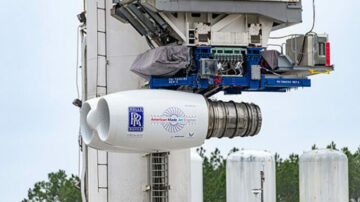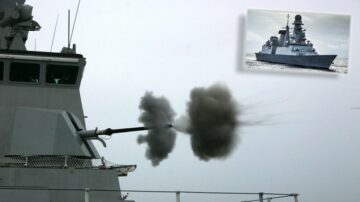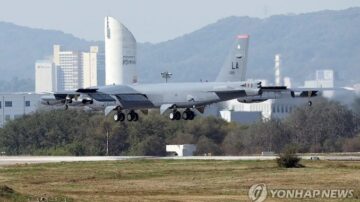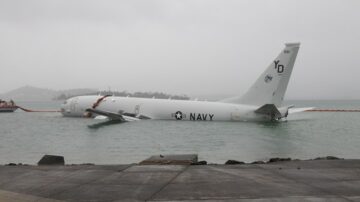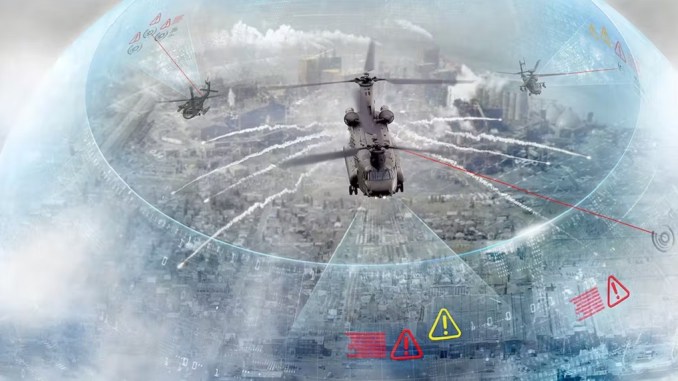
The new $114 million Common Missile Warning System (CMWS) contract confirms the renovated focus on aircraft survivability against novel advanced threats.
BAE Systems has been awarded a $114 million Foreign Military Sale by the U.S. Army for AN/AAR-57 Common Missile Warning Systems (CMWS) to be installed on allies’ existing fleets and newly acquired aircraft, including AH-64 Apaches, CH-47 Chinooks and UH-60 Black Hawks. The combat proven system is installed on more than 40 different aircraft types around the world, which have accumulated more than 4 million combat hours.
“Battlefields are increasingly contested, and airborne armed forces around the world must be able to detect and defeat modern infrared threats,” said Jennifer Bartley, deputy product line director of Integrated Survivability Solutions at BAE Systems. “When stealth is not an option, CMWS provides a shield that enables aircraft survivability and mission execution.”
The sophistication and proliferation of infrared-guided missiles continue to increase and defeating them effectively is crucial, especially as they are often hidden until fired and can strike in seconds, requiring more advanced aircraft survivability equipment. The lessons learned from recent conflicts underlined the need to protect low flying aircraft, and especially helicopters, also from MAN-Portable Air-Defense Systems (MANPADS) threats, other than direct fire that is contrasted with the use of armor.
CMWS is an ultra-violet based missile warning system, part of an integrated IR countermeasures suite utilizing five sensors to display accurate threat location and dispense decoys/countermeasures. The system consists of five Electro-Optic Missile Sensors that are mounted to the surface of the aircraft, an Electronic Control Unit, a reprogrammable User Data Module, a Sequencer, and Improved Countermeasure Dispensers, according to info release by the Army’s Project Management Office for Aircraft Survivability Equipment.
Although CMWS was initially fielded in 2005, BAE Systems continuously customized the algorithms to adapt to new threats and CMWS has now reached Generation 3. The latest generation of this system’s technology integrates hostile fire indication, missile warning, and data recording capabilities into one unit, allowing detection of small arms fire and rocket-propelled grenades while also enabling data recording for detailed post-mission analysis.
The Common Missile Warning System’s sensors and electronic control unit. (Photo: BAE Systems)
” data-medium-file=”https://i0.wp.com/theaviationist.com/wp-content/uploads/2024/02/BAE_Systems_CMWS_FMS_2.jpg?fit=460%2C259&ssl=1″ data-large-file=”https://i0.wp.com/theaviationist.com/wp-content/uploads/2024/02/BAE_Systems_CMWS_FMS_2.jpg?fit=706%2C397&ssl=1″ decoding=”async” class=”size-large wp-image-84796″ src=”https://platoaistream.net/wp-content/uploads/2024/02/u-s-army-awards-new-common-missile-warning-system-fms-contract-to-bae-systems-1.jpg” alt width=”706″ height=”397″ srcset=”https://platoaistream.net/wp-content/uploads/2024/02/u-s-army-awards-new-common-missile-warning-system-fms-contract-to-bae-systems-1.jpg 706w, https://platoaistream.net/wp-content/uploads/2024/02/u-s-army-awards-new-common-missile-warning-system-fms-contract-to-bae-systems-2.jpg 460w, https://platoaistream.net/wp-content/uploads/2024/02/u-s-army-awards-new-common-missile-warning-system-fms-contract-to-bae-systems-3.jpg 128w, https://platoaistream.net/wp-content/uploads/2024/02/u-s-army-awards-new-common-missile-warning-system-fms-contract-to-bae-systems-4.jpg 768w, https://platoaistream.net/wp-content/uploads/2024/02/u-s-army-awards-new-common-missile-warning-system-fms-contract-to-bae-systems-5.jpg 678w, https://i0.wp.com/theaviationist.com/wp-content/uploads/2024/02/BAE_Systems_CMWS_FMS_2.jpg?w=1024&ssl=1 1024w” sizes=”(max-width: 706px) 100vw, 706px” data-recalc-dims=”1″>
CMWS only does the first part of the job, as it then directs countermeasures to effectively defeat the threat. One of the most used is BAE Systems’ AN/ALE-47 Airborne Countermeasures Dispenser System, which is the standard on many NATO aircraft, although laser-based directional infrared countermeasure systems are getting a larger role nowadays. Among these DIRCM systems are Northrop Grumman’s CIRCM and Leonardo’s Miysis.
The new Common InfraRed CounterMeasures system is the lightweight dual-jammer DIRCM system designed specifically to protect U.S. Army’s rotary wing and medium fixed wing aircraft from infrared-guided missiles. The system, which reached the Initial Operational Capability last year, uses a dual-jammer configuration as it provides spherical protection and the highest level of aircraft survivability, compared to a single head DIRCM.
Miysis can be considered directly related to the CMWS, as BAE Systems and Leonardo received last year the approval from the United States government to proceed with the development of a new aircraft survivability suite which integrates both systems. The new suite will maximize the effectiveness of CMWS flare decoying while enhancing the protection against from IR MANPADS with a highly effective DIRCM.
- SEO Powered Content & PR Distribution. Get Amplified Today.
- PlatoData.Network Vertical Generative Ai. Empower Yourself. Access Here.
- PlatoAiStream. Web3 Intelligence. Knowledge Amplified. Access Here.
- PlatoESG. Carbon, CleanTech, Energy, Environment, Solar, Waste Management. Access Here.
- PlatoHealth. Biotech and Clinical Trials Intelligence. Access Here.
- Source: https://theaviationist.com/2024/02/08/u-s-army-awards-new-cmws-contract/?utm_source=rss&utm_medium=rss&utm_campaign=u-s-army-awards-new-cmws-contract
- :has
- :is
- :not
- 1
- 125
- 2%
- 2005
- 4
- 40
- a
- Able
- According
- Accumulated
- accurate
- Achieve
- acquired
- adapt
- advanced
- Aerospace
- aerospace engineering
- against
- aircraft
- algorithms
- Allowing
- also
- Although
- among
- an
- analysis
- and
- applied
- approval
- ARE
- areas
- armed
- arms
- Army
- around
- AS
- At
- avatar
- awarded
- awards
- BAE Systems
- based
- BE
- been
- Black
- both
- by
- CAN
- capabilities
- capability
- combat
- Common
- compared
- Configuration
- conflicts
- considered
- consists
- continue
- continuously
- contract
- contributor
- control
- crucial
- Current
- customized
- data
- defeating
- Degree
- deputy
- designed
- detailed
- detect
- Detection
- different
- direct
- directly
- Director
- directs
- Display
- does
- Effective
- effectively
- effectiveness
- Electronic
- enables
- enabling
- end
- Engineering
- enhancing
- equipment
- especially
- Ether (ETH)
- execution
- existing
- expertise
- Fire
- fired
- First
- five
- fixed
- flare
- flying
- Focus
- For
- Forces
- foreign
- freelance
- from
- generation
- getting
- Government
- graduate
- Have
- he
- head
- helicopters
- Hidden
- highest
- highly
- his
- HOURS
- HTTPS
- improved
- in
- Including
- Increase
- increasingly
- indication
- info
- initial
- initially
- installed
- integrated
- Integrates
- into
- IT
- Italy
- Jennifer
- Job
- journalist
- jpg
- larger
- Last
- Last Year
- latest
- learned
- Level
- lightweight
- Line
- location
- Low
- management
- many
- master
- max-width
- Maximize
- medium
- Military
- million
- missiles
- Mission
- Modern
- module
- more
- most
- must
- Need
- New
- newly
- novel
- now
- of
- Office
- often
- on
- ONE
- only
- operational
- Operations
- Option
- osint
- Other
- part
- photo
- plato
- Plato Data Intelligence
- PlatoData
- proceed
- Product
- project
- project management
- proliferation
- protect
- protection
- proven
- provides
- reached
- received
- recent
- recording
- related
- release
- Role
- s
- Said
- seconds
- sensors
- Shield
- single
- small
- Solutions
- sophistication
- specifically
- standard
- States
- Stealth
- strike
- Studying
- suite
- Surface
- system
- Systems
- techniques
- Technology
- than
- that
- The
- the world
- Them
- then
- These
- they
- this
- threat
- threats
- to
- types
- u.s.
- underlined
- unit
- United
- United States
- until
- use
- used
- User
- uses
- Utilizing
- warning
- was
- which
- while
- will
- Wing
- with
- world
- year
- zephyrnet


